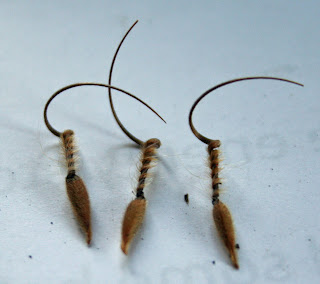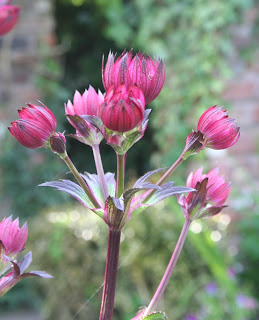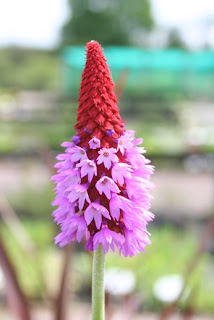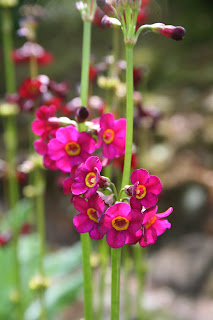I love growing new plants. If I could, I would happily spend all my working days (and a bit more time besides), sowing seeds, taking cuttings, dividing, nurturing, and potting my babies on until they are old enough to live on their own.
 |
| Stipa capillata seeds |
You might say – well, you run a nursery now so you’ve got your wish! Partly, yes. But there’s the garden to maintain and improve, staff to organise, ordering compost/pots/new plants, the tea room to run, accounts, queries, watering to do (lots!) and, of course, the all important customers to look after. Often, my spell in the potting shed is a quiet hour at the end of the day when everyone else has gone home. It is bliss.
I ran two propagation workshops last week and am running two more this week. I take a group of nine people, explain some core principles, demonstrate some techniques and then take them into the potting shed to get stuck into a pile of plants. It’s great fun and everyone seems to enjoy themselves. All of the workshops have been full, with a waiting list too.
In response to the huge interest there seems to be in propagation, I’m going to share some of my thoughts on this blog in a series of posts – in a logical sequence, I hope! To narrow things down a bit I’m going to stick to my personal field of interest – hardy plants, especially hardy perennials and shrubs. If you were here for one of last week’s workshops this might be a handy refresher. If you’re here this week – read on or don’t as you see fit! We just dip into this for the first 5 minutes anyway….
Where to start?
At first glance there seem to be a myriad of different ways to make new plants. But, at the heart of it, there are really just two…
1. From seed
If you’re lucky this week, you’ll spot a drift of primroses (Primula vulgaris) which have self-seeded in a pretty mass of lemon yellow along a woodland bank. To the naked eye they all look identical.
 |
| Astrantia maxima |
But to make a seed, a plant has to fuse two separate sets of DNA together from a male and a female cell. No matter how alike the parents may look, a new plant grown from seed is never absolutely identical to its parents or its siblings.
Many superb garden plants also come ‘true’ from seed and are reliable performers year in year out. Knowing which ones you can rely on to come true is key. The next section below explores this in more detail.
2. From part of the parent plant.
But many of our favourite garden plants are cultivars – carefully bred over many years, or discovered by chance as one off variations. Mostly, they don’t come true from seed. To produce another plant the same, you need to take a piece of the parent plant and clone it. Not only will it look identical, it will actually be genetically identical. Fortunately, cloning a plant is a lot easier than cloning Dolly the Sheep.

In the plant world, cloning is called vegetative propagation and there are a myriad of methods. It can be as basic and brutal as slicing the plant in two with a spade, as fiddly as nipping off a little shoot and persuading it to grow roots in a pot on a windowsill, or as technical as taking a tiny piece of a leaf and growing a baby plant in a test tube (I can’t do this and neither can you, unless you have access to a micropropagation lab). However it is done, the result is a true genetic clone of the parent plant and it will look identical too. We’ll talk more about vegetative propagation in later posts.
What will I get if I grow plants from seed?
Good question. Most gardeners, when they think about growing from seed, tend to imagine vegetable growing, annual flowers, or wildflowers perhaps. Attractive, garden worthy, long-lived plants aren’t their first thought and possibly don’t feature at all. I’m not sure why that is. Perhaps because that’s what most of the seed racks are filled with at garden centres.
 |
| Primula vialii |
But there are a great many wonderful ornamental plants that can be easily and cheaply grown from seed. The question is, how do you know what you will get from your seeds? Will a plant come true or will it vary?
If you know the proper, botanical name for your plant, the answer to the question is easy – it’s right there, in the name. Any plant with just two parts to its name – Genus and species – will come true from seed (OK, that’s not an absolute rule, but it’s a great place to start). Someone gave it a Genus+species name, possibly centuries ago, precisely because it can reproduce itself reliably from seed. It’s a very handy piece of information.
- Primula vialii – stunning plant, most unlike any other Primula
- Lychnis chalcedonica – Maltese cross, you may know it as?
- Verbena bonariensis – shockingly overpriced in some garden centres – it’s seed raised!
- Knautia macedonica, – like a magenta scabious – very pretty indeed
- Geranium wlassovianum – gorgeous purple flowers – perhaps my favourite geranium
- Aconitum napellus – tall, rich blue, early to flower and wickedly toxic
- Catananche caerulea – a papery delight in our dry front garden
All of these lovely, hardy and perennial plants are grown from seed here on the nursery and grow true to their name. Growing from seed means we can produce a great many plants more cheaply than if we bought in plugs from elsewhere and gives me a reliable supply.
But I know my plant is a named cultivar. What will I get if I sow its seeds?
So your plant name will look something like this:
- Astrantia major ‘Ruby Wedding’
- Brunnera macrophylla ‘Jack Frost’
- Gaura lindheimeri ‘The Bride’
- Geranium ‘Orion’
- Delphinium ‘Astolat’
If your plant does produce seed the plants you get may look more like the parents they were bred from than your choice plant. You can at least be certain that the seed from Astrantia major ‘Ruby Wedding’ will produce an Astrantia major of some sort. You may get a new and lovely form. But even if your offspring look remarkably like the plant you collected the seed from, it wouldn’t really be right to call it by that name if you were thinking of giving it or selling it to someone else. You could say ‘seed raised from …’ or ‘ex … ‘ which is the more normal convention.
You sometimes see ‘Series’, ‘Strain’ or ‘Hybrids’ as part of the cultivar name. This tells me that they are usually seed raised. The plants may vary visibly in appearance, but perhaps have a common feature such as height or leaf colour. Kniphofia ‘Bressingham Hybrids’ and Geranium pratense ‘Midnight Reiter Strain’ are good examples.

I don’t mind that they are grown from seed – how great that we can grow such great plants so readily! But I still feel instinctively twitchy about putting a cultivar name on a seed raised plant. Sorry to confuse you…. It certainly confuses me.
What if I don’t know the name of my plant?
That willl do for now. In the next post we’ll talk about successful sowing and growing from seed. There might be a little video too….
11 Responses to “Propagating plants – To sow, or not to sow?”
lovely post Sue and helpful to me
A most informative post Sue which conveys your enthusiasm for the subject – thank you. I remember your advice when I attended one of your courses that if you look carefully at the plants they will tell you what you need to do to propagate them. Look forward to your next post. Astrantia 'Star of Fire' looks most tempting. Have you got any at the nursery? If so I feel a trip coming on!
Many thanks for this post. Have been seed collecting / sowing for 20 years or more and still picked up very useful info from your post.
Great post and very hepful information for people learning about propogation. I wish i had such clear and concise wrting on the subject when i first learnt! For me putting cultivar names on some seed raised plants just helps with identifying a strain which has certain charecteristics that differ from the species. It just takes more time to learn which cultivars will come true from seed!
I think the blame lies with the seed merchants when it comes to “cultivars” grown from seed – I guess the process is that they see a promising cultiivar, try getting a seed crop from it, find that the progeny are pretty close to the original, and so start selling the seeds.
Growers can't resist the lure of large volumes of cheap, seed raised "cultivars" of course, so the market becomes flooded with the seed raised strains. Then the original vegetatively prop'd plants start to look very expensive on the garden centre shelves, and so the seed raised strains take over….
There are problems of course – after several, perhaps many, generations of sexual reproduction, the plants characteristics start to drift from those of the original cultivar, and it loses some of its appeal.
You can see this happening in practice – Lavandula angustifolia 'Hidcote' has been seed raised for many years, but the seed merchants have recognised that it has drifted from its parent, and you can now find 'Hidcote superior' in the seed catalogues – an attempt to re-select for the original plant characteristics. Still not the original cultivar though!
Similarly, Echinacea 'Magnus' has been seed raised for years, but recognising that the seed raised form is moving away from the original cultivar, 'Magnus superior' can now be found in the seed catalogues – again, an attempt to clean up the drift from the parent.
There has also been comment in the blogosphere in recent years about Tomato 'Gardeners Delight' – always a seed raised variety I think, but allegedly becoming something of a shadow of the original strain.
So in short, cultivars cannot, and really should not be seed raised – but commercial pressures take over some times, and corners get cut…
I love it when I think I know some stuff and find something out I hadn't even known I didn't know, if you get what I mean! Interesting post, thank you.
Thanks for the feedback – glad so many found it helpful.
Nick – not sure who you are, no link from your name. Am definitely interested to progress this discussion – it's of great interest to me to get this question of seed raised cultivars understood.
Sorry Sue, didn't mean to come over all mysterious – just think leaving links on blog comments looks too much like link-farming sometimes.
Anyway, I'm a long way from being any sort of expert on this – you'll have to attract a proper botanist to the discussion if you really want to sort it!
Very helpful contribution on the subject, Nick. Always delighted to hear from fellow nursery owners.
As far as im aware the more generations you grow a selection the more stable it will become. Most cultivars that come true from seed are grown for a few years and constantly reselected and then named after a sufficient period that a true plant can be guarenteed. This has to be closely monitored by the seed companys to stop the cultivar drifting away from its original characteristics.
Thanks Will,
Monitoring for changes by seed companies is only really effective if their monitored seed is the only source. But of course any nursery, including mine, which notes that a cultivar is grown from seed might then decide to do so from their own locally collected seed and that control is then lost.
I've had the occasional white Echinacea from batches of bought in 'Rubinstern' plants, so I figured there was no point paying a premium for them. I raise my own now, collecting seed from first generation stock each time. I guess that makes me part of the 'problem' but then, I didn't start it…